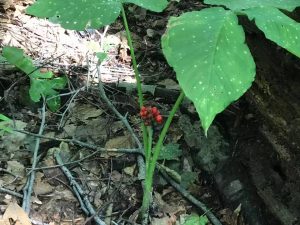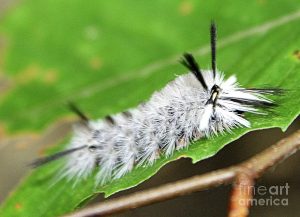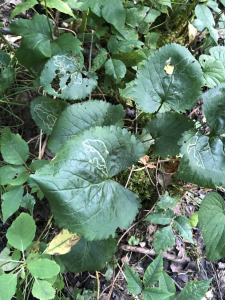As I walked along the wooded path of Johnson’s Woods, I noticed the “good” and “bad” impacts it had on the surrounding nature. The “bad” impact that I recognized most was the graffiti markings on the slick and smooth beach trees. Moreover, most of these markings were due to the easy access of nature via the wood path. Therefore, I would argue that if not for the wood path a lot of these markings would not be there. However, as I walked even deeper into the woods I noticed a squirrel run right below the wooded path. At this moment, I realized the “good” impact of the wooded path. The “good” impact the wooded path had was its ability to provide shelter to several animals or plants that could otherwise be killed. Ultimately, the big lesson I took away from Johnson’s woods was the two sided affect humans have on nature. We are able to cultivate nature and simultaneously destroy it.
Johnson’s woods
Johnson’s wood is the first forest that I entered and observed in America. Usually, if people built a track to let people enter the forest in china, the forest is not natural already. Because they will make lots of changes to it by making it look “better”. I love how the creatures are so naturally working by themselves outside the track here. I also love how the track is showing part of the perspective of this forest but not changing a lot to it. Trees are falling on the sides, mushrooms growing on the rotting woods or the ground and wild plant having red fruits. While I was walking, I also heard something is moving under the leaves on the ground. I also love the streams of the sun fell through trees, filling up every space between the leaves with sugary light, I stared at these gaps of lights over and over.
Walking the paths and looking around. Although it is very similar views I still want to keep walking and looking. 

The Chirps of Dead Crickets
Walking through Johnson’s Woods, I close my eyes and listen, enraptured by the sound of crickets chirping in the trees and grasses around me. I think about what those chirps mean: calls of loneliness and anxiety, reaching out for companionship or nervously marking territory.
Then I notice something off.
One of the chirps seems to be getting louder.
As a classmate passes me on the boardwalk, I realize that her phone is going off. Her ringtone, coincidentally, is the sound of a cricket chirping. I chuckle at the realization, then stop to consider its implications.
When those crickets were recorded for that ringtone, they were chirping for a reason. Like the crickets around me now, they were seeking a mate or a space of their own, setting their boundaries or calling others in to join them.
The average cricket lives for less than ninety days. Those crickets are long dead.
And yet they still chirp. Their song still fills the air, and now their kind hear it and respond, in conversation with the dead.
goldenrod & going in circles
I’m a sucker for a good goldenrod plant. The bright yellow inevitably pops against the color of the surrounding foliage in a way that you only start really appreciating once you start looking for it everywhere you go. You see it everywhere in Ohio; it’s not an uncommon plant. Still, I always get a pang of nostalgia for days spent rummaging in the woods behind my aunt Terry’s house and coming across the weed-like plant. At Johnson’s Woods, there are a handful peeking out just by the entrance before you walk into a sea of green. (Green leaves, brown bark, blue piece of gum stuck to the trunk of a tree.) The colors inside Johnson’s Woods are stunning, of course–looking up at the tops of trees towering over my mere 5’7″ frame makes me feel small in the awe-inspiring way only particularly cool bits of nature can. But the flowers are what have stuck with me.
The flowers, and the graffiti. The standard initials were annoying at first, but as I began collecting notes of the more outrageous comments, a simple “KW + ER” was the least of my concern. Some had returned to mark out their partners names in the ultimate statement of a broken heart. On one tree, someone etched “Van Halen” in big bold font. Another had taken the time to write out “Will you be my bitch?” in an attempt at what I can only imagine to be romance. Worse yet, one tree featured a carefully carved swastika. It just makes me wonder what could possibly be going through folks’ minds–white supremacy isn’t exactly an easy topic to fully grasp, sure, but who took the time and effort to etch “Kansas” into a beech with no context? Why did someone find it pressing enough to write “lemon” into a tree, to be left there for future guests to find? Why vandalize a tree at all–what do you gain, other than a few splinters? We all want to make our mark–but is here really the place? Is anywhere really the place when the outcome is just a blow to the natural landscape? Where do we draw the line?


Graffiti Is A Bad Look
I had a very familiar feeling in Johnson’s woods. I was reminded of the woods behind my town hall back in Wellesley, MA. There were little ponds and creeks, old trees, various wildlife, etc. People walk around back there and take in the sights. Some of them are teens and preteens, aimlessly looking for something entertaining. At night, they would use the woods to drink, smoke, and graffiti the trees and bridges. I remember feeling bored–when nothing seemed interesting and everything cost too much money.
I could tell that people use Johnson’s woods in the same inappropriate way when they felt bored. I looked at the graffiti and I knew what happened in these woods at night. Despite seeing the children and families that were no doubt genuinely enjoying the woods, I felt sad. There were so much stupid graffiti: people broadcasting their relationship status, bored people writing whatever they could think of on the bark, something to make that day feel meaningful. That swastika wasn’t a great look, either. It’s a shame to see something so old and beautiful defaced to provide some fleeting feeling of satisfaction. To those children who walk the woods, the graffiti must look as normal as moss. There’s no doubt in my mind that in ten years, they’ll add to the graffiti.
The Lone Survivor
In my class the Gilded Age, we are learning about how settlers created homes in the U.S. by chopping down trees and creating log cabins, I was thinking about that while I wondered how is this place still here? The border between the farmland and the forest makes this place feel rare. I was impressed that this area has survived for so long given its location. When I was able to ignore the mosquitos and the tree graffiti, I enjoyed surveying the forest.
I am from outside of Seattle and have easy access to lots of forested areas. I’m ashamed to admit that as a junior this was my first time visiting a forest in Ohio. I was curious about what was going to be different. I miss the woods and the outdoors that I have at home when I’m at school and found the trip to Johnson’s Forest refreshing. I took some photos on my phone and my favorite ones are the ones looking up at the canopy of trees with the blue sky peeking through.

The Island
What really struck me about Johnson’s woods was its location, its sense of place within the wider environment. For most of our drive, I stared out the window, in particular I noticed when the bike path just outside of town started and then abruptly stopped a mile or so later. Helpful. Passing though Smithville and the other neighborhoods that line the highway, it was clear that we were going into the more rural expanses of northeast Ohio. These fields are flat, agricultural land, producing great quantities of corn and soy. They dominate their prospective fields and are sometimes graced with a proud chemical sign alluding to the their genetic make up.
Once we could see the great expanse of foliage ahead of us, I was quite astonished. Not to say it was a new sight to my eyes, but the view itself, the contrast of the woods with its surroundings, really struck me. The great Hickories and Oaks of enormous height towered over us as we passed through the green tunnel. And then we reached the other side. I realized why this felt so strange. Here was a forest “untouched” through the ages, a survivor, now isolated and trapped within this feat of progress, modern agriculture. What kind of forest is this anyway?
Have No Fear the Insects Were There
When I first got to Johnson’s Woods, I was impressed by how “woody” the area was. One of the first things I wanted to do once I separated from the group was to look for insects. Over the summer I had an internship with the Ohio Agriculture Research Development Center (OARDC) that involved scouting for insects in fields. I mainly scouted a small broccoli and potato field. Scouting involves looking for insects and looking for evidence of what they had eaten. Along the boardwalk I found a caterpillar walking along. I was unaware of what kind of caterpillar this was, but it was covered in white hair and had some black spikes. The caterpillar was fun to watch because it would walk a bit, and then pick up its front half and thrash it around. I was told during my internship that this is a defense mechanism and an attempt by the caterpillar to seem scary, but to me it was cute. I have since googled the caterpillar, and it was a Hickory Tussock caterpillar whose hair is venomous. It turns out this caterpillar had a reason to be walking around like it owned the place.
Another insect I noticed was the leaf miner. A leaf miner is a broad term for any insect whose larvae mines a leaf (like a coal miner). An entire plant had all of its leaves fall prey to leaf miners, yet I couldn’t help but enjoy the patterns and contrasting colors the miners left. There were interesting loops that remind me of the path of someone with no worries, and the leaves were of a dark rich green, with the trails of the leaf miner being the color of milk. I enjoyed being able to appreciate the beauty of the leaf miners instead of having to note its presence on a piece of paper. One thing my internship taught me was that insects are always present; you just have to stop and wait for them to come out. Johnson’s Woods is filled with insects and has a thriving ecosystem.
The Caterpillar

source:https://www.google.com/search?q=hickory+tussock+caterpillar&source=lnms&tbm=isch&sa=X&ved=0ahUKEwiYrIqswrjkAhVQQq0KHRW5AXgQ_AUIEygC&biw=1477&bih=718#imgrc=e088SbeOopFTGM:
Leaf Miner Damage

source: myself
Johnson’s Woods Trip
I have been to Spangler Park many times since arriving at the College of Wooster my freshman year. Until our trip to Johnson’s Woods, I had really never considered any other places to hike in Wooster. Upon arriving, I was pleasantly surprised by the wooden boardwalk that makes the Woods more accessible to people with disabilities. It also creates a more obvious pathway that discourages people from straying. This helps to protect the wildlife of the area. While many beach trees were damaged by people walking by, much of the Woods appeared undamaged. In fact, the plant life seemed far more healthy and lush than that of Spangler. While this observation could have been skewed by the time of day, there appeared to be far more green than I had ever seen before along the trails of Ohio. I am excited to return to Johnson’s Woods in the Spring to witness the blooming of many flowers.
